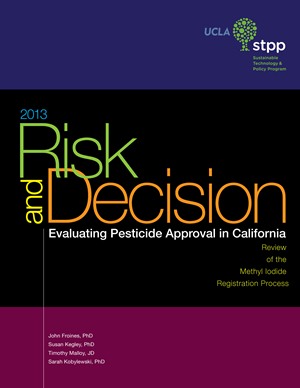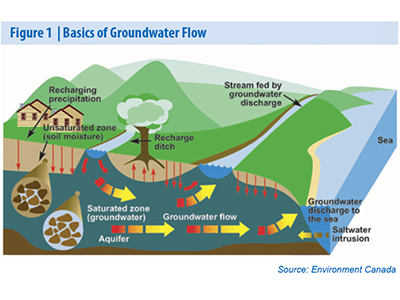Region: California
Environmental Impacts of Fracking: Three Layers of the Onion
This summer, The Emmett Center at UCLA jointly sponsored with the Union of Concerned Scientists a two-day workshop on unconventional oil and gas production technologies, aka fracking: two days of expert working groups on science and risk assessment, law and regulation, and public information and engagement, followed by a public forum. The public forum was …
Continue reading “Environmental Impacts of Fracking: Three Layers of the Onion”
CONTINUE READINGPesticide Registration: Time for an Upgrade
UCLA Study Offers Recommendations to Improve the Pesticide Approval Process in California
We love our fresh fruits, vegetables and nuts in California. They are healthy for us and for our economy; California leads the nation with agricultural revenues of over 44 billion dollars annually, and produces nearly half of the fruits, nuts and vegetables grown in the U.S. But modern agriculture relies heavily on fumigants to produce this bounty …
Continue reading “Pesticide Registration: Time for an Upgrade”
CONTINUE READINGReforming Groundwater Adjudications: New Pritzker Environmental Policy Brief
A new report discusses groundwater in CA.
The Emmett Center on Climate Change and the Environment has released its latest Pritzker Environmental Law and Policy Brief, “Allocating Under Water: Reforming California’s Groundwater Adjudications.” California leads the nation in groundwater extraction, but it lags behind in updating groundwater-related laws and regulations. As a result, protracted litigation clogs the courts and often fails to protect water …
Continue reading “Reforming Groundwater Adjudications: New Pritzker Environmental Policy Brief”
CONTINUE READINGBreaking News: Ninth Circuit Upholds California’s Low Carbon Fuel Standard
Does California’s life cycle analysis of the carbon intensity of transportation fuel facially discriminates against out-of-state ethanol?
In a sweeping victory for the California Air Resources Board, the Ninth Circuit today issued an opinion in Rocky Mountain Farmers Union v. Corey upholding the state’s Low Carbon Fuel Standard (LCFS) and reversing a lower court ruling that the LCFS facially discriminated against interstate commerce in violation of the U.S. Constitution. The court also vacated the …
Continue reading “Breaking News: Ninth Circuit Upholds California’s Low Carbon Fuel Standard”
CONTINUE READINGCEQA Reform 2013: Long-Overdue Changes for Infill and the Environment
It looks like State Senate pro Tem Darrell Steinberg might finally be putting the “E” back in “CEQA,” at least when it comes to how California’s premiere environmental law treats traffic impacts. His bill SB 731 to reform the California Environmental Quality Act (CEQA), previously discussed by Eric, is taking aim at the law’s perverse …
Continue reading “CEQA Reform 2013: Long-Overdue Changes for Infill and the Environment”
CONTINUE READINGCalifornia Poised to Take a Major Step Forward on Energy Storage
Energy storage isn’t called the “Holy Grail” for nothing. Without it, we simply cannot meet our long-term greenhouse gas reduction goals. To decarbonize the energy supply, intermittent renewable energy from the sun and wind must be stored for later dispatch when those resources aren’t available. We’ve covered this subject extensively here and here. Now California …
Continue reading “California Poised to Take a Major Step Forward on Energy Storage”
CONTINUE READING(Tentative) ruling in cap-and-trade case looks good for CA: ARB has auction authority
It’s never over till it’s over, but for now California is breathing a little easier as it defends its cap-and-trade allowance auctions from two high-profile industry challenges. The cases, which Ann has discussed here and here, were filed by the California Chamber of Commerce and the Pacific Legal Foundation, and they make both statutory and …
CONTINUE READINGShark Fins, Federal Preemption & the Ninth Circuit–An Update
Last week I wrote about an interesting, pending lawsuit involving a constitutional challenge to California’s recently-enacted ban on the sale, possession or trade of shark fins. Asian restauranteurs and cultural advocates who’d filed the lawsuit and failed in their earlier efforts to persuade the federal district court to enjoin the law appealed that ruling to the U.S. Court of Appeals for …
Continue reading “Shark Fins, Federal Preemption & the Ninth Circuit–An Update”
CONTINUE READINGFeds Argue California’s Shark Fin Ban Is Preempted in Third-Party Litigation
In 2011, the State of California enacted a ban on the sale, possession and trade of shark fins. California’s ban follows similar laws passed by Hawaii, Washington and Oregon over the past few years. The legislation, codified as California Fish & Game Code sections 2021 and 2021.5, followed years of advocacy by marine conservation groups, …
Continue reading “Feds Argue California’s Shark Fin Ban Is Preempted in Third-Party Litigation”
CONTINUE READINGUCLA / UC Berkeley Law Report on High Speed Rail Policies for California’s San Joaquin Valley
The environmental law centers at UCLA and UC Berkeley Schools of Law are releasing today a new report on policies to maximize the economic and environmental benefits of high speed rail in the San Joaquin Valley. “A High Speed Foundation: How to Build a Better California Around High Speed Rail″ is the eleventh report in …
CONTINUE READING







